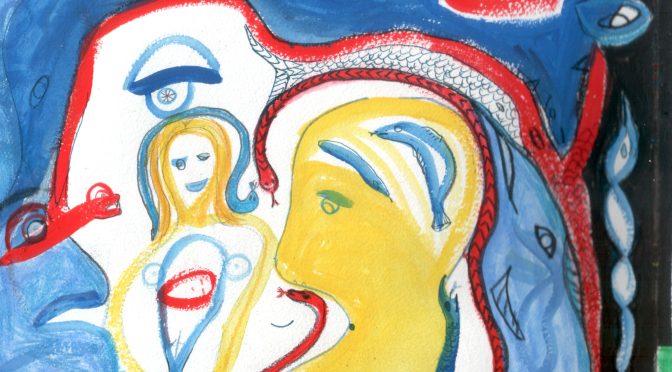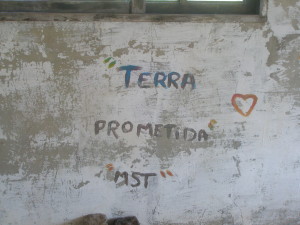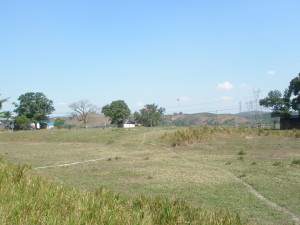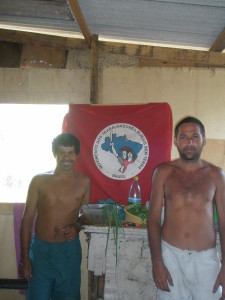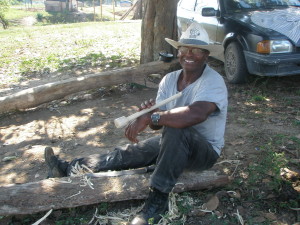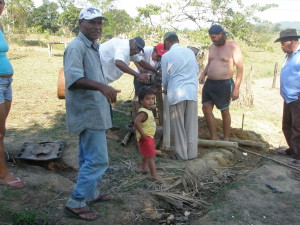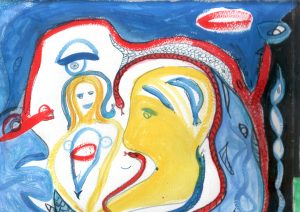 After blacks and Jews, will emigrants be the scapegoats of our so-called liberal and right-thinking societies? Nothing new under the sun, you might ask! For this theme has been around for as long as mankind has been on the move, in other words, since the dawn of time, but for the last thirty years or so, it’s been getting tougher; ever since the emigrant had the misfortune to have the dark complexion of a North African worker, or the black skin of a sub-Saharan African laborer. The result of the legislative elections in the Netherlands is a sad illustration of this. The rise of the far right, as in the 1930s, is a recipe for fascism and mafias, with war an inevitable outcome! Fear will have changed sides, encouraged by the ignorance and indifference of the right-wingers. And in the end, someone will have to pay their weight in flesh and blood to calm the ardor of the madmen who will then be in charge. But this time, surprise! It will no longer be the anonymous members of minorities whose sacrifice we will be moved to discover, but our very humanity that is in danger of disappearing. This is where the danger lies.
After blacks and Jews, will emigrants be the scapegoats of our so-called liberal and right-thinking societies? Nothing new under the sun, you might ask! For this theme has been around for as long as mankind has been on the move, in other words, since the dawn of time, but for the last thirty years or so, it’s been getting tougher; ever since the emigrant had the misfortune to have the dark complexion of a North African worker, or the black skin of a sub-Saharan African laborer. The result of the legislative elections in the Netherlands is a sad illustration of this. The rise of the far right, as in the 1930s, is a recipe for fascism and mafias, with war an inevitable outcome! Fear will have changed sides, encouraged by the ignorance and indifference of the right-wingers. And in the end, someone will have to pay their weight in flesh and blood to calm the ardor of the madmen who will then be in charge. But this time, surprise! It will no longer be the anonymous members of minorities whose sacrifice we will be moved to discover, but our very humanity that is in danger of disappearing. This is where the danger lies.
The mechanisms of resentment and rivalry that lead to this predicted disaster have long been known. Freud opened the way by explaining how desire works; René Girard added to this understanding the spiral of mimetic rivalry that leads to conflict and the sacrifice of the scapegoat. Culture and education are the only way to guard against this. And that means knowing our own family history. Many of us will be surprised to discover how closely this history is linked to immigration. Who doesn’t have a father, mother or grandfather who didn’t come from somewhere else? A good quarter of French society has foreign origins. “France is diversity”, as the historian Fernand Braudel once said. The same is true of our contemporary societies as a whole. Forgetting this history condemns us to death. So what’s to be done? Those who are in a position to speak out, to bear witness to their experiences as sons or grandsons of migrants, must speak out. And now. All the time. All the time. I’m not unaware of the toxic influence of social networks, which the craziest among us seize upon to impose their delusions. I’m not fooled by these hijackings and I’m aware that this exhortation will have little echo. But we have to start somewhere, or start again. As the son and grandson of emigrants, having lived in three different countries myself, I cannot accept the appalling silence in which we are condemned by the manipulations of a few. So today I urge all those who can to do so. Speak out now. Afterwards, it will be too late.
Category Archives: What Am I Doing Here?
Je trouve le dessin de Charlie Hebdo sur le tremblement de terre en Italie dégueulasse, méchant, etc. Mais…
Giuseppe A. Samonà
Quand quelques amis, à l’unisson avec la presse quasiment unanime, s’insurgent indignés, faisant remarquer que ce dessin ne fait pas rire, une question me vient à l’esprit : et pourquoi donc devrait-il faire rire? La satire ne doit pas être confondue avec l’humour, elle ne fait pas rire, ou plus exactement elle peut faire rire, mais ce n’est pas son objectif. Elle doit provoquer, heurter, faire preuve parfois de « méchanceté », voire même être « dégueulasse », pour susciter une réflexion politique et sociale. Ni Dante – qui en fait abondamment usage, et dont on a dit et répété que sa manière de parler de Mahomet faisait pâlir, par sa violence, les fameuses vignettes de Charlie Hebdo– ni Voltaire, auteur satirique s’il en est, n’ont jamais fait rire personne. Cela dit, on peut aimer la satire ou ne pas l’aimer : moi par exemple je ne l’aime pas, ou pour mieux dire, je ne l’aime pas quand elle est utilisée de manière exclusive, comme si elle était à elle seule un moyen pour comprendre et raconter le monde : d’ailleurs, je ne suis pas un lecteur de Charlie Hebdo et n’ai que très rarement apprécié ses dessins… Mais on ne peut pas demander à ce journal d’être ce qu’il n’est pas.
Les mêmes amis, et la même presse, ajoutent encore plus indignés : non content de tourner les victimes en dérision, ce dessin reprend des stéréotypes lourdement racistes et xénophobes… Là encore, on doit s’interroger. Les journalistes de Charlie Hebdo, de par leur histoire, leur appartenance culturelle, leur orientation politique, manient la dérision – y compris en utilisant les morts – avec désinvolture et souvent une certaine obscénité, mais c’est sur les meurtriers, les bourreaux, et non sur les victimes, que portent leurs sarcasmes: est-il possible qu’en cette occasion ils aient dérogé à leur vocation atavique ? Et surtout que des intellectuels cultivés et raffinés aient repris à leur compte un grossier cliché raciste, vieux de presque cent ans, qui n’a plus cours même parmi les plus rustres et les moins instruits ? Non, seule une totale méconnaissance des mécanismes de la satire caractéristiques de Charlie Hebdo pouvait attribuer à ces journalistes une telle intention. Si on analyse le dessin à l’intérieur de Charlie Hebdo – les journaux qui ont lancé la polémique l’ont présenté sans rien, hors contexte, en partie tronqué – en s’appuyant aussi sur les nombreuses interventions dans les réseaux sociaux de ceux qui, contrairement à la presse officielle, l’ont compris et ont pris sa défense (parmi les plus significatives, voir l’article publié dans Gli Stati Generali, et la discussion qui s’en est suivie; ou les prises de position de Sabina Guzzanti, ou encore Roberto Saviano, on comprend que le dessinateur ne s’en prend pas aux victimes, mais à ceux qui ont construit les maisons ou les ont laissé construire d’une certaine manière, en contournant, ou en négligeant les critères qui s’imposent de manière impérative dans une zone à risque sismique élevé – l’exhibition du corps des victimes permet seulement, ni plus ni moins qu’une photographie, de constater un fait: si on construit des maisons avec du sable au lieu de ciment (penne gratinées), elles s’écroulent sur leurs habitants, les réduisant à l’état de viande hachée bonne à faire des lasagne, dont se nourrissent aussi ceux qui profitent de la reconstruction pour s’enrichir cyniquement et malhonnêtement, comme cela s’est passé à l’Aquila. Bref, ce dessin, de manière provocatrice, veut dénoncer un scandale: ce n’est pas le tremblement de terre mais l’Italie, le système Italie, qui a causé tous ces morts et tous ces blessés; les morts ne sont pas morts du tremblement de terre mais de l’Italie. Du système Italie. Simplification, raccourci, slogan ? Certainement. Néanmoins, il n’est pas moins sûr que, comme le souligne Norma Rangeri dans le Manifesto du 25.08, « Aucun pays industrialisé, présentant un risque sismique très élévé comme le nôtre, n’est pulvérisé chaque fois que la terre tremble. » (Et moi j’aurais envie d’ajouter : … avec une magnitude ne dépassant pas 6 degrés). A noter, pour corroborer cette interprétation, la phrase qu’on peut lire un peu plus loin plus loin dans Charlie Hebdo sous la rubrique “Les couvertures auxquelles vous avez échappé” : « On ne sait pas si le tremblement de terre a crié ‘Allah U Akbar’ au moment de se produire ». Référence claire à L’ennemi d’aujourd’hui, bouc émissaire par excellence – et ce sont les journalistes que cet ennemi a si durement frappés qui se moquent de cela ! – que l’on charge aujourd’hui de tous les maux dont souffre la société. Quant à l’image de la « pasta », son usage raciste (les macaronis d’antan) est devenu une antiquité poussiéreuse, digne d’un « Musée de l’insulte xénophobe»; il est difficile de penser qu’elle a pu être utilisée au premier degré, avec l’intention d’injurier. Il ne reste, au second degré, que son évidente capacité à représenter immédiatement l’Italie, un peu comme le camembert pourrait représenter la France. A ce propos, une dernière remarque : Charlie Hebdo se moque de tout, il ne connaît ni limites ni frontières, il semble prendre un plaisir presque sadique à frapper les personnes et les idées aux endroits les plus sensibles, France comprise, et c’est pourquoi un grand nombre de Français ne le supportent pas et ne perdent pas une occasion de l’attaquer ; de toutes les accusations dont Charlie Hebdo a été l’objet, celle de chauvinisme est vraiment la plus injuste et la moins fondée.
Le dessin t’a donc plu? demandent les indignés… Non, mais s’il me déplaît, c’est pour d’autres raisons. Outre le fait que la satire comme vision du monde n’est pas ma tasse de thé, c’est en général l’exhibition de la douleur et du corps des victimes qui me pose problème, eût-elle pour objectif de dénoncer le meurtrier. De ce procédé, Charlie Hebdo fait un usage immodéré et volontairement de mauvais goût, souvent crypté (c’est le cas ici) et incompréhensible pour qui n’est pas un exégète confirmé du journal ; le public non averti, à commencer par les victimes elles-mêmes, ne peut y voir qu’une grossière atteinte à la dignité des morts et des blessés, si bien que le dessin finit par produire un effet opposé à celui qui était visé. D’ailleurs, à propos de ce même événement, le dessin scandaleux de Felix a été suivi par un dessin de Coco qui se présente comme une clarification provocatrice face au tollé général suscité en Italie par le premier : “Italiens, ce n’est pas Charlie Hebdo qui construit vos maisons, c’est la mafia”. Certains diront : qui n’aime pas ce genre de satire, n’a qu’à ne pas acheter le journal. C’était juste dans les années 70 et suivantes, ce ne l’est plus aujourd’hui : pour peu qu’il y ait un intérêt à créer un « cas », n’importe quelle image est instantanément diffusée aux quatre coins du globe, y compris auprès de ceux qui n’achètent pas le journal. D’ailleurs Charlie Hebdo a bien conscience de cette possibilité de manipulation et s’en sert, ne serait-ce que pour se faire de la publicité. Il y a en somme un grand décalage entre les intentions, qui circulent et sont comprises dans un public restreint, et le résultat, qui finit par s’adresser au grand nombre et tombe, comme un excrément mal ciblé, à côté de la cuvette (… fuori dal vaso, vieux dicton populaire italien). C’est pourquoi on peut dire que cette satire échoue à faire réfléchir (car on ne peut appeler « réflexion », ou du moins pas dans le sens recherché par le dessin, le concert de vociférations qui s’est déchaîné, ni même le besoin de discussion qui s’est manifesté aussi à ViceVersa…), et qu’elle a manqué son but. Dans l’ordre de la satire, en effet, quand on passe de l’écriture à un dessin, potentiellement accessible à tous, il faudrait, justement pour cette raison, être beaucoup plus incisif, avoir bien plus de finesse et de capacité à franchir les frontières: Altan ou Philippe Geluck possèdent cette vocation à l’universalité et racontent un monde, les dessins de Charlie Hebdo, non (du moins à notre avis) ; ils ne sont compréhensibles qu’à l’intérieur d’un cercle restreint de d’initiés. Sans renoncer à l’incontournable (pour Charlie Hebdo) effet macabre, n’aurait-il pas été plus efficace, pour faire passer le message, d’introduire au milieu des décombres quelques politiciens ou entrepreneurs du bâtiment? En ce sens, les occasions d’inspiration en Italie ne manquent pas …
La chose toutefois la plus ahurissante, pour moi (et c’est ce qui est à l’origine de ces lignes), est l’extraordinaire vague d’indignation collective – celle-ci, oui, teintée d’un certain chauvinisme – qui a rassemblé l’Italie contre l’infâme dessin, à l’intérieur et hors des institutions : de la droite fasciste de Forza Nuova, qui regrette que “nous ne les ayons pas tous tués, ces salauds de Français”, à la gauche du Manifesto (03.09.16), qui, dans un article étonnement superficiel, et embarrassant, de Tommaso di Francesco, conclut que « l’arrogance et le mauvais goût restent d’ insupportables spécificités françaises ». Je ne suis plus Charlie : ainsi se sont insurgées de nombreuses personnes qui avaient fait leur le célèbre slogan apparu il y a un peu plus d’un an; ils doivent s’excuser, affirment d’autres, le dessin doit être publiquement condamné (et l’ambassade de France de déclarer que « le dessin ne représente pas la position officielle de la France » !!!) ; les dessinateurs doivent être mis au pilori, on en est même arrivé à une véritable dénonciation au Tribunal par le maire d’Amatrice – et cela sans parler des menaces de mort visant les journalistes et des horreurs qui foisonnent à leur sujet sur le web. Aux repentis du Je suis Charlie, moi (qui n’ai jamais adhéré au fameux slogan mais défendrai toujours l’existence de Charlie et le droit de dessiner « satiriquement »), voudrais rappeler que ce dessin n’est pas meilleur ni pire que beaucoup d’autres du même genre – et même il y en a eu de plus vulgaires, de plus insultants et de plus révoltants : ceux par exemple qui s’ « inspirent » des victimes du génocide au Rwanda, ou des enfants syriens morts en traversant la Méditerranée, ou encore, pour rester dans le même sujet, du tremblement de terre en Haïti. Certes, tous ces dessins ont donné lieu à l’époque à des protestations – pas en Italie, toutefois–, mais jamais à une tempête comparable à celle qui vient de se déchainer en Italie, justement : au moins en ce sens-là il s’agit bien d’une affaire italienne.
Entendons-nous bien. Une chose est la douleur en elle-même, celle des victimes et de ceux qui se sont sentis offensés par ce dessin : devant la douleur des autres on ne peut ni ne doit porter aucun jugement, on ne peut que témoigner silencieusement sa sympathie et sa solidarité. Autre chose en revanche est l’élaboration intellectuelle de cette douleur ; la fabrique de l’indignation collective, les initiatives qui s’en suivent, le recours à des termes comme “honneur” et “outrage”, tout cela suscite une certaine perplexité… Il est difficile de ne pas penser (mutatis mutandis) aux réactions provoquées dans le monde musulman par les dessins (mauvais eux aussi!) sur le Prophète. Un mauvais dessin touche à quelque chose de sacré (ici le Prophète, là les morts), déchaînant un ouragan collectif disproportionné du point de vue rationnel, mais compréhensible, « proportionné » d’un point de vue religieux, qui considère ce qui est sacré comme intouchable, et les images comme étant en elles-mêmes dotées de pouvoir. C’est là- dessus qu’il faudrait réfléchir, plus que sur un mauvais dessin qui ne mérite pas tant d’attention. Il faudrait aussi s’interroger sur un curieux déplacement politique. Au lieu de s’en prendre aux choses elles-mêmes, on s’en prend à la représentation des choses ; la fureur collective s’est acharnée sur un médiocre dessin en se détournant de la réalité dénoncée par ce dessin: de ceux qui, par leurs malversations, leur corruption, leur indifférence, leurs investissements absurdes ou frauduleux, sont responsables, du moins en partie, des désastres environnementaux qui s’abattent régulièrement sur l’Italie.
EUROPE. Satire? Dazibao sur Charlie Hebdo
Une caricature de “Charlie Hebdo” scandalise l’Italie
Ainsi titre Le Point dans son site internet du 2 septembre mais on pourrait citer d’autres sites français (http://www.lepoint.fr/medias/une-caricature-de-charlie-hebdo-scandalise-l-italie-02-09-2016-2065563_260.php)
Satire ?! Scandale? Ce qui choque, au de-là de la désolante, triste stupidité de cette caricature de Charlie Hebdo sur le tremblement de terre qui a pulvérisé la ville d’Amatrice faisant 300 morts, est qu’en France on en fasse une « affaire italienne ». Comme si la douleur, la bêtise avaient des frontières nationales …Pas d’espoir pour l’Europe si, en France, les médias n’ont pas le courage de condamner cette “satire” humainement, universellement cruelle et gratuite.
Lamberto Tassinari
_______________________________________________________________
Je sais plus qui je suis….
Je n’ai jamais été vraiment fasciné par le tabloïd, je le trouve de mauvais gout bien des fois mais comme Voltaire je me battrai pour qu’il ait sa place parmi les autres média. Cependant la liberté d’expression semble porter à certains mépris de l’humain chez Charlie et une fois de plus il s’y illustre bien.
Beaucoup de choses se cachent derrière le geste de Charlie :
La catastrophe, en Italie, est « nationale », c’est ailleurs déjà, donc on peut en rire, sans limite. Je n’ose pas imaginer l’inverse et une France meurtrie par un tremblement de terre faire l’objet d’un pareil sarcasme. Je vois d’ici les boucliers se lever et les leçons de bonne conduite assenées à tout va
Les Italiens sont de la « pasta », ce qui n’est pas sans rappeler les vocables qui qualifiaient cette immigration en France, chacune ayant son appellation. Pour les Nord-Africains, c’était « bougnoul » par exemple, les Portugais, des “Portos”, les Polonais, des “Polaks”.
C’est donc une pauvre France que Charlie perpétue ainsi.
Charlie qu’on a pu prendre une foultitude de fois, la main dans le sac, franchissant cette frontière que personne ne peut lui contester au nom de la liberté d’expression
Qu’est ce qui a pris à Charlie de faire de l’humour bourré de mépris sur une tragédie humaine ?.
C’est juste incompréhensible, inqualifiable, lamentable
Karim Moutarrif
And this is how I saw the “Near East”
Giuseppe A. Samonà
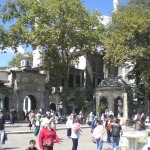
Città d’oriente tripudio di moschee di chiese polidosse di solitarie sinagoghe di viuzze che si intrecciano l’una con l’altra d’improvvisi spazi sontuosi piazze grandi alberi tropicali di nuovo stradine viuzze un odore stordente di seta di spezie e tutte tutti formicolanti di gente stretta in una tremenda morsa di caldo, ma ci hanno detto per carità non bevete mai l’acqua solo acqua minerale e noi siamo così giovani così belli: non vogliamo non possiamo morire.
Quel sole sopra le nostre teste però che brucia martella, quell’aria che sembra bagnata e non un filo di vento non una traccia d’ombra, noi appoggiati esausti sul muretto che delimita la grande pianura pietrosa intarsiata d’arabeschi vuota di umani, quell’arsura la gola secca un bisogno un’urgenza la sete ci divora ci uccide ma non un bar un chiosco un venditore ambulante – solo, in lontananza, al limite opposto, i carrozzoni sonnecchiosi di un circo disposti in semicerchio; con di fronte, nel mezzo, una fontana di marmo che vomita potente senza mai interrompersi: acqua, acqua tersa limpida trasparente profumata scintillante di frescura e purezza – com’è possibile che tanta bellezza sia un subdolo inganno, una trappola? Pure, sappiamo: un sorso, anche uno solo, e saremo morti. Morti.
Allora ci avvicina un uomo, un giovane, ma più vecchio di noi, più maturo (porta infatti dei folti baffi neri). Avete sete? (sì, ce lo dice nella nostra lingua segreta: ma come avrà capito?) E senza attendere la risposta, indica la fontana. Per aggiungere rassicurante – intuisce il nostro esitare – che possiamo bere senza timore: lui è medico. E sa. Con certezza. Non c’è inganno, trappola – quell’acqua è proprio come sembra: tersa, limpida, pura… Mentre noi rassicurati siamo già con le mani sul marmo della fontana (lui ci ha seguito, spiegando), e beviamo beviamo, avidi, insaziabili. Felici. Quindi, ancora gocciolanti, lo guardiamo, lui, l’amico, il nostro salvatore – che spostando il suo dito indicante verso la sinistra rivela finalmente – e il tono della sua voce si fa perentorio – l’inoppugnabile prova: Ci ha bevuto l’orso!
L’orso. Che dalla sinistra, sul fondo, l’estremità d’una catena alla zampa (l’altra estremità è tenuta da un omaccione, anche lui baffuto), trotterella docile, si dirige verso di noi, la fontana. La morsa di caldo è tremenda, e ha di nuovo sete.
…
N.B. The “Near East” is the geographical area more commonly referred to today as the “Middle East”. It is the term generally employed by archaeologists and historians of the Ancient World. For biographical reasons I prefer it to the more contemporary appellation, especially when dreaming about the past and revisiting memories. The title is a near quotation from Joseph Conrad, one of my favourite classical writers.
(Vedi anche: Et c’est encore ainsi que le Proche-Orient m’apparaît)
Água de Rebelião
Jeremy Lester
The human river that flowed along the asphalt through the night, discharging at the gate of the plantation, stops and backs up like the waters of a weir. The women and children are quickly sent to the rear of the ‘dam’, while the men take positions at the front of the imaginary line to prepare for the possible confrontation with the plantation’s jagunços.
With no reaction from the latifundio’s small army, the men in the vanguard break the padlock and the gate opens wide. They enter. Behind them, the human river begins to move. Scythes, hoes and banners are raised in the unrestrained avalanche of hope in this re-encounter with life – and the repressed shout of the landless sounds as one voice in the brightness of the new day…
Sebastião Salgado
La Terra Prometida (The Promised Land). Oh, how many times has this name been solemnly and proudly pronounced only to be found inexistent in reality; nothing more than a dream or a well-named utopian ‘no place’. Yet occasionally, just occasionally, dream and reality do coincide. This is the case here, or so it seems to me. To be sure this is no land of Kenites, Kadmonites, Hittites, Rephaites, Amorites and Jebusites. If this really is a New Jerusalem, it is as far distant from the old one as one can possibly imagine. Yet as one looks at the land that stretches out before us, one realises just why the two Old Testament books of Genesis and Exodus are invoked so frequently even here. The space before us seems not only endless, but remains for the most part untouched by human hands and human toil. It is a virgin space if ever there was one, a space of eternal genesis, of constant becoming, or, to use the terminology of Alain Badiou, an ‘event site’, a ‘point of exile where it is always possible that something might [and will] happen.’[1]
Where, you might ask, am I? Well, I am in the still largely barren rural landscape that continues to dominate much of the peripheral borders of the state of Rio de Janeiro in Brazil, and the purpose of the visit is to lend a hand in being a midwife to a ‘birth’. As you might gather, this is no ordinary birth. What has been conceived here is a new ‘occupation’, and the proud parents of this birth are the local activists of the Movimento dos Trabalhadores Rurais Sem Terra (MST); a movement that during the course of its thirty year existence has increasingly come to be recognised, and rightly hailed, as not just one of the largest, but also one of the most astute, modern, dynamic, moral, integral and ambitious social movements anywhere in the world today. Such eulogies, I can assure you, are not misplaced and stem directly from its actual record of achievement. As a direct result of its land occupation strategies – in a country renowned of course for having one of the most unjust, unequal land distribution systems in the world[2] – it has helped to settle hundreds of thousands of families across more than eight million hectares of formerly unproductive land. Not only that. With a membership not far short of two million people and with a strong presence in all but three regional states and in several hundred municipalities, it also runs several hundred production, commercialisation, and services associations, many of which are organised into collective and semi-collective production cooperatives. It carries out all of its own training activities and it administers no less than two thousand schools, in which several thousand students teach basic literacy to 50,000 children, teenagers and adults. It also has its own university and partnerships with fifty-nine other universities throughout the country, and has won much recognition, as well as awards, from UNESCO and UNICEF for all its educational activities. In the areas under its control, it has virtually eliminated child mortality (which is certainly not the case elsewhere in the country), and has won much acclaim for many of its other community policies, particularly in the sphere of culture.
What lies before me, then, is a landscape waiting to be formed out of vacant space; a becoming landscape in the creative distance of space-time. I say waiting to be formed, but ‘carved’ would be a more appropriate term. For isn’t this what peasants are: sculptors of time, sculptors of earth, modelling a realm of culture out of nature? And isn’t an occupation of this kind like a work of art; one whose task is not to reproduce what is visible, but to make things visible?
The occupation itself, fortunately, had gone very smoothly, and already there were the usual signs and images that accompany an encampment in this very early stage of its development: the hastily constructed shacks (lonas pretas) with their black plastic protective covering, the endless hustle and bustle, toing and froing, and of course the rippling red flag marking its entrance, emitting a glow as if it were a ‘great bonfire, announcing that [here] the slaves seek freedom and inviting others like them to forge together their own destiny.’[3] If the scene in front of me could be painted, it would take, I think, a Bruegel – that ‘Shakespeare of popular life’[4] – to do it full justice. Both the landscape and the people in it lend themselves naturally to someone of his talent, ability and wit. Above all, no one more than he would best be able to capture the image of these people as they truly are in themselves. And do not get me wrong. I am not implying that there is a large degree of naivety and innocence here; far from it. But there is a simplicity about the scene which is certainly not equivalent to innocence. In one corner of the ‘canvas’, illuminated by the early morning sun, there is a man sitting on the ground sharpening and preparing the tools that he needs for the forthcoming day’s labour, with such a smile on his face that he looks fit to burst with joy. In another corner, there are the men grooming the horses in preparation for their own exertions of the day. Nearby, there are women hanging out washing on a makeshift line. While elsewhere, in a scene wonderfully reminiscent of Bruegel’s ‘Children’s Games’, the young boys and girls of the encampment are busy in their own activities, no doubt dreaming of the day when the little school will be ready for them, whose terrain has already been chosen and marked out. And what I would want my Bruegel to do more than anything is to capture all of their jovial, roguish, animated faces and expressions, as only he could do with such economy and flare, in strong colours and bold compositions, so as to lend the scene all of the epic humanity – and indeed the frailty of it as well – that it so deserves.
But the most prominent part of this ‘canvas’ must be reserved for another scene altogether, a Bruegelesque ‘allegory of hope’ if ever there was one. There before us is a small group of people who have been working away since the crack of dawn on the most important task of all. A spring has been located and by the end of the day a makeshift pump needs to be constructed so as to give the occupants of the encampment a ready supply of ‘blue gold’ close to their new homes. It is this scene that will shape the destiny of the lives of these people for as long as they live. And it is not a vain destiny of fleeting images, but an essential destiny that will endlessly change the substance of being.[5] As W.H.Auden so aptly put it: ‘Thousands have lived without love, not one without water.’[6]
Everything commences with water. All things are flowing. How right the ancient sages were. It is by means of water that we measure time and structure space. And is it any wonder that there were so many cults of water in ancient times, many of which remain alive today. It is the source of everything in life. It is in itself, in its very essence, the closest thing to a ‘god’ as one can possibly get. Is it not for this reason that it is the bearer of life and of hope; the hope of something to come?
Every space, meanwhile, has its own ingrained form of resistance. Every occupation of space must find ways of overcoming this resistance. But for the occupation to succeed, there must also be a communication with that space. The construction of the pump represents precisely this. It is a ‘communicating vessel’ with the land, which literally plumbs the depth of primitive and eternal being, as well as the wellspring of the deepest emotions possible. And what emotions are on display in this immanent space. You can see the anticipation in their eyes. You can see their thoughts taking shape and their dreams carrying them off down the flowing streams of consciousness. And being immanent, it is a space that is ‘actualised at every moment in terms of the whole of one’s “affections” (which are nonetheless in constant variation).’[7]
The time of waiting is a fertile time, especially here where time seems to languish, affording one the luxury of time (and space) to contemplate, to create; magic time fending off the conquistadors of ordinary, insipid time.[8] As the men labour away to create the simple pumping mechanism that will connect the virgin spring to the virgin community, it is inevitably the material consequences of having a permanent water supply that initially dominates everyone’s thoughts. Our perspective, in other words, remains grounded in relation to the earth. But as the day wears on, a strange sensation starts to take hold. The imagination begins to dominate matter entirely, and the seemingly ordinary (sic) event that we are witnessing moulds us as visionaries. As a consequence, the waiting is gradually transformed, metamorphosed. It is now as though we are waiting for the arrival of someone after a long peregrination, a long adventure. And by the early hours of the evening, when the work is finally completed, the transformation of our thoughts and reflections is absolutely profound.
As the handle is turned, the waiting seems endless. Time itself has been eclipsed. When, at long last, the first drop appears and seems to hang there in elastic suspension, trembling, clinging to the end of the pipe before the inevitable descent, it is not so much joy, but a strange sort of primitive sadness and melancholy that grips me. Sadness, because one can sense what sacrifice is being made here by the water; one can feel a sense of loss. Melancholy, because it is the destiny of all water to suffer the most acute form of homesickness. Once it leaves its source, it will never be able to return. It is a permanent emigrant. The pain of water, it is often said, is infinite, for all living water is on the point of dying. Indeed, not for nothing is water often traditionally viewed as a sort of confine, a limen, between life and death.[9] And yet for all this, the sadness and the melancholy are not oppressive. They rest lightly on the mind, because one also feels that the sacrifice is voluntary. If in the ‘eye of the water’ one can detect a tear, it is not necessarily a tear of anguish, but perhaps also of contentment, satisfaction, liberation.[10] For let’s not forget that water is also permanently young. It never grows old.
As the first drop turns into a slight trickle it takes on the form of a hand reaching out to embrace the earth. When the trickle turns into a slow but steady flow, the embrace is transformed into a dance. And then, finally, when the flow is transformed into a veritable gushing forth of water, it is like a beautiful voice singing a cool, liquid melody in radiant harmony. It is a playful voice, more playful than even Ravel or Liszt could ever imagine; one that smiles as it sings, one that echoes our own inextinguishable thirst for life.[11]
And so the bonding between water and earth is complete and the reproductive cycle can commence. From the downward flow of water from Mother Nature’s breast, new life can surge upwards. But just as importantly the land, as it had once been, has likewise been purified, and through its purification it has become truly liberated. Newly cleansed and refreshed, the energy of youth has been returned to it. Not only did we all drink the water in celebration, we kissed it. And as we did so, it was like looking into a mirror of our soul.
Fresh water awakens and gives youth to one’s face, that place where a man sees himself growing old and where he would like to keep others from seeing him age! But fresh water does not rejuvenate our faces for others so much as for ourselves. Beneath the awakened brow gleams a new eye. Fresh water puts fire back in the eye. There lies the principle of inversion that explains the true freshness of the contemplation of water. It is our outlook that is refreshed.[12]
As the light of the approaching evening is filtered not just through the sight of water flowing, but its sound as well, the two senses become united into a single perception. Our sense of smell is also altered as water and night unite their gentleness. ‘For a soul at peace with itself, water and night together seem to take on a common fragrance; it seems that the humid shadow has a perfume of double freshness. Only at night can we smell the perfumes of water clearly. The sun has too much odor for sunlit water to give us its own.’[13]
Was it just my imagination or did everything already look greener, more fertile? And what liquid quality was now given to our speech? No doubt it was the effect of the celebratory eau-de-vie – the marriage of water and fire – for we were now back in the domain of Bruegel: in the Land of Cockaigne.
__________
*I would like to express my sincere thanks to the journal ViceVersa. It was after seeing their very interesting documentary, Ô Saint-Laurent: une histoire d’eau et d’appartenance, that I was moved to send them this contribution on the theme of water and its primary public role in all our lives. When treated with the proper respect not only does water serve our human needs of basic survival, but it can also actively respond to our call for human dignity, community and solidarity.
Água de Rebelião (Rebellion Water) is the title given to a collection of poetry by Hamilton Pereira (Petrópolis: Vozes, 1983).
NOTES
[1] For a very good overview of Badiou’s ideas, see Peter Hallward, ‘Order and Event: On Badiou’s Logics of Worlds’, New Left Review, 53, 2008, pp. 97-122.
[2] According to official statistics, the landmass of Brazil is 850 million hectares, of which half is considered cultivable. However, in practice, only 60 million hectares have thus far been exploited for agricultural production. In terms of ownership structures, meanwhile, 1.6 per cent of private landowners possess 46.78 per cent of the land.
[3] See Ademar Bogo, ‘The Culture of the Sem Terra’, http://www.landless-voices.org, p.4.
[4] This description of Bruegel is by Max Dvorak. See also his History of Art as the History of Ideas (London: Routledge and Kegan Paul, 1984).
[5] See Gaston Bachelard, Water and Dreams. An Essay on the Imagination of Matter, trans. Edith R. Farrell (Dallas: Pegasus Foundation, 1983), p. 6.
[6] W.H. Auden, ‘First Things First’ (1957) in Edward Mendelson (ed), W.H. Auden: Collected Poems (London: Faber and Faber, 1976), p. 445.
[7] D.M. Smith, ‘Deleuze and Derrida, Immanence and Transcendence: Two Directions in Recent French Thought’, in P. Patton and J. Proteri (eds), Between Deleuze and Derrida (London: Continuum, 2003), p. 62.
[8] For more on the peasant conception of time see Michel Onfray, Les Formes du temps. Théorie du sauternes (Paris: Mollat, 2009).
[9] See Vito Teti (ed), Storia dell’acqua. Mondi materiali e universi simbolici (Roma: Donzelli, 2003), p. 24.
[10] There is a spring in the desert that the Tuaregs call ‘the eye of the water’ (shet-n-aman).
[11] Ravel and Liszt are arguably the two classical composers most inspired by the element of water.
[12] Bachelard, Water and Dreams, p. 145. Underpinning these reflections is the manner in which water, and especially springs, ‘is an irresistible birth, a continuous birth. The unconscious that loves such great images is forever marked by them. They call forth endless rêveries… impregnated with mythology.’ (Ibid, pp. 13-14). If I am influenced predominantly by Bachelard here I make no apologies at all. For one thing, he is the most peasant-like of philosophers. And for another thing of all the places where his works have made such an impact outside of France, Brazil is second to none.
[13] Ibid, p. 104.

